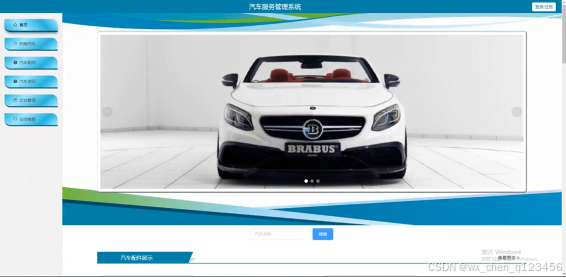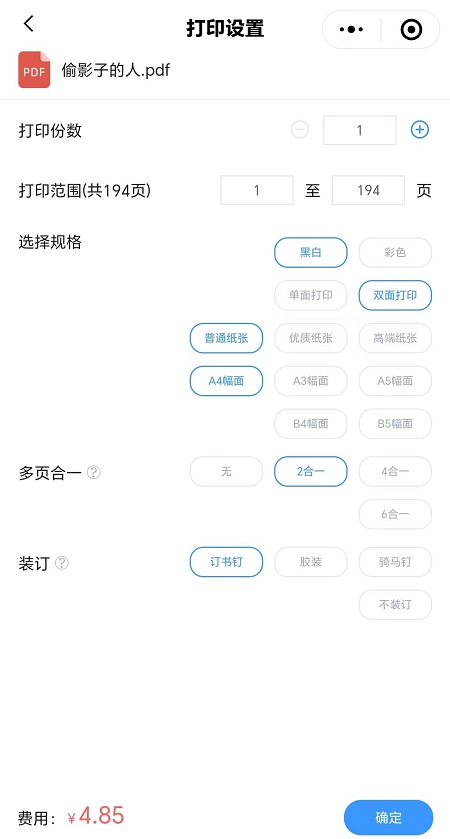本文展示Spring Boot中,新版本OAuth2.0的简单实现,版本信息:
spring-boot 2.7.10
spring-security-oauth2-authorization-server 0.4.0
spring-security-oauth2-client 5.7.7
spring-boot-starter-oauth2-resource-server 2.7.10
展示三个服务,分别为
- 授权服务:作为认证中心,用于向客户端发放授权码code与令牌token
- 资源服务:保存客户端要访问的资源
- 客户端:向授权服务发起请求,获取授权码code,再用code换取token,最后使用token访问资源
授权服务搭建
总体预览
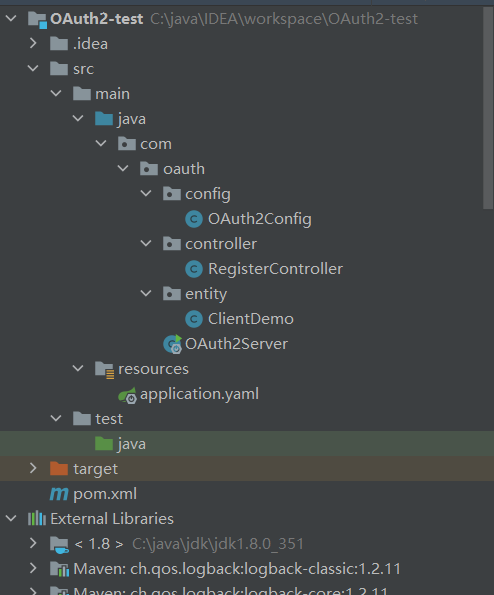
pom
<?xml version="1.0" encoding="UTF-8"?>
<project xmlns="http://maven.apache.org/POM/4.0.0"
xmlns:xsi="http://www.w3.org/2001/XMLSchema-instance"
xsi:schemaLocation="http://maven.apache.org/POM/4.0.0 http://maven.apache.org/xsd/maven-4.0.0.xsd">
<modelVersion>4.0.0</modelVersion>
<groupId>org.example</groupId>
<artifactId>OAuth2-test</artifactId>
<version>1.0-SNAPSHOT</version>
<properties>
<maven.compiler.source>8</maven.compiler.source>
<maven.compiler.target>8</maven.compiler.target>
</properties>
<parent>
<groupId>org.springframework.boot</groupId>
<artifactId>spring-boot-starter-parent</artifactId>
<version>2.7.10</version>
</parent>
<dependencies>
<dependency>
<groupId>org.springframework.boot</groupId>
<artifactId>spring-boot-starter-security</artifactId>
</dependency>
<dependency>
<groupId>org.springframework.security</groupId>
<artifactId>spring-security-oauth2-authorization-server</artifactId>
<version>0.4.0</version>
</dependency>
<dependency>
<groupId>org.springframework.boot</groupId>
<artifactId>spring-boot-starter-web</artifactId>
</dependency>
<dependency>
<groupId>org.springframework.boot</groupId>
<artifactId>spring-boot-starter-jdbc</artifactId>
</dependency>
<dependency>
<groupId>mysql</groupId>
<artifactId>mysql-connector-java</artifactId>
<version>8.0.28</version>
</dependency>
<dependency>
<groupId>cn.hutool</groupId>
<artifactId>hutool-all</artifactId>
<version>5.8.26</version>
</dependency>
<dependency>
<groupId>org.projectlombok</groupId>
<artifactId>lombok</artifactId>
</dependency>
</dependencies>
<build>
<plugins>
<plugin>
<groupId>org.springframework.boot</groupId>
<artifactId>spring-boot-maven-plugin</artifactId>
</plugin>
</plugins>
</build>
</project>
配置类
import com.nimbusds.jose.jwk.JWKSet;
import com.nimbusds.jose.jwk.RSAKey;
import com.nimbusds.jose.jwk.source.JWKSource;
import com.nimbusds.jose.proc.SecurityContext;
import org.springframework.beans.factory.annotation.Autowired;
import org.springframework.context.annotation.Bean;
import org.springframework.context.annotation.Configuration;
import org.springframework.jdbc.core.JdbcTemplate;
import org.springframework.security.config.Customizer;
import org.springframework.security.config.annotation.web.builders.HttpSecurity;
import org.springframework.security.config.annotation.web.configuration.EnableWebSecurity;
import org.springframework.security.config.annotation.web.configurers.oauth2.server.resource.OAuth2ResourceServerConfigurer;
import org.springframework.security.crypto.bcrypt.BCryptPasswordEncoder;
import org.springframework.security.crypto.password.*;
import org.springframework.security.crypto.scrypt.SCryptPasswordEncoder;
import org.springframework.security.oauth2.jose.jws.MacAlgorithm;
import org.springframework.security.oauth2.jwt.JwtDecoder;
import org.springframework.security.oauth2.server.authorization.JdbcOAuth2AuthorizationConsentService;
import org.springframework.security.oauth2.server.authorization.JdbcOAuth2AuthorizationService;
import org.springframework.security.oauth2.server.authorization.OAuth2AuthorizationConsentService;
import org.springframework.security.oauth2.server.authorization.OAuth2AuthorizationService;
import org.springframework.security.oauth2.server.authorization.client.JdbcRegisteredClientRepository;
import org.springframework.security.oauth2.server.authorization.client.RegisteredClientRepository;
import org.springframework.security.oauth2.server.authorization.config.annotation.web.configuration.OAuth2AuthorizationServerConfiguration;
import org.springframework.security.oauth2.server.authorization.config.annotation.web.configurers.OAuth2AuthorizationServerConfigurer;
import org.springframework.security.oauth2.server.authorization.settings.AuthorizationServerSettings;
import org.springframework.security.oauth2.server.authorization.settings.ClientSettings;
import org.springframework.security.oauth2.server.authorization.settings.TokenSettings;
import org.springframework.security.provisioning.JdbcUserDetailsManager;
import org.springframework.security.provisioning.UserDetailsManager;
import org.springframework.security.web.SecurityFilterChain;
import org.springframework.security.web.util.matcher.RequestMatcher;
import javax.sql.DataSource;
import java.security.KeyPair;
import java.security.KeyPairGenerator;
import java.security.interfaces.RSAPrivateKey;
import java.security.interfaces.RSAPublicKey;
import java.time.Duration;
import java.util.HashMap;
import java.util.Map;
import java.util.UUID;
@EnableWebSecurity
@Configuration
public class OAuth2Config {
@Autowired
private JdbcTemplate jdbcTemplate;
@Autowired
private DataSource dataSource;
@Bean
UserDetailsManager userDetailsManager() {
return new JdbcUserDetailsManager(dataSource);
}
@Bean
public SecurityFilterChain authorizationServerSecurityFilterChain(HttpSecurity http) throws Exception {
// 定义授权服务配置
OAuth2AuthorizationServerConfigurer configurer = new OAuth2AuthorizationServerConfigurer();
// 获取授权服务器相关的请求端点
RequestMatcher endpointsMatcher = configurer.getEndpointsMatcher();
http
.authorizeHttpRequests(authorize -> authorize
// 配置放行的请求,/register用于客户端及用户的注册
// /register/*代表放行api下的单层路径,/register/**代表其下的所有子路径
.antMatchers("/register/**", "/login").permitAll()
// 其他任何请求都需要认证
.anyRequest().authenticated()
)
//配置登录页,用于授权请求未认证时进行用户登录授权
.formLogin()
.and()
// 忽略掉相关端点的CSRF(跨站请求伪造攻击防御): 对授权端点的访问不被CSRF拦截
.csrf(
csrf -> csrf.ignoringRequestMatchers(endpointsMatcher)
//如果是post请求,即便上面已经放行,还是会被csrf过滤器拦截,所以针对post请求,如果开启了csrf防护,需要再配置放行
.ignoringAntMatchers("/register/**")
)
// 使用BearerTokenAuthenticationFilter对AccessToken及idToken进行解析验证
// idToken是开启OIDC时,授权服务连同AccessToken(就是访问资源需要的token)一起返回给客户端的,用于客户端验证用户身份,结合此处配置使用BearerTokenAuthenticationFilter来验证idToken
.oauth2ResourceServer(OAuth2ResourceServerConfigurer::jwt)
// 应用授权服务器的配置,使其生效
.apply(configurer);
configurer
//开启oidc,客户端会对资源所有者进行身份认证,确保用户身份的真实性、防止身份伪造、增强安全性。
// 开启后,除了访问令牌access_token,还会多一个用户身份认证的idToken
.oidc(Customizer.withDefaults())
//配置用何种方式保存注册的客户端信息,默认为内存保存,这里配置为数据库保存,表名为'oauth2_registered_client'
//保存客户端注册信息,主要用于后续各种认证时对比客户端是否有效
.registeredClientRepository(registeredClientRepository())
//配置用何种方式保存OAuth2客户端的授权请求的信息。这包括授权码、访问令牌、刷新令牌等。
// 默认为内存保存,这里配置为数据库保存,表名为'oauth2_authorization'
//授权信息会作为认证依据,在后续请求token时被读取,不存在授权信息则不给客户端生成token
.authorizationService(authorizationService())
//配置用何种方式存储用户对客户端请求的授权同意(consent)信息。
// 默认为内存保存,这里配置为数据库保存,表名为'oauth2_authorization_consent'
//请求code时检查是客户端否已授权,未授权不予code
.authorizationConsentService(authorizationConsentService())
/**
* OAuth2AuthorizationService 与 OAuth2AuthorizationConsentService区别:
* oauth2_authorization 主要与令牌管理相关,负责存储令牌及其生命周期信息。
* oauth2_authorization_consent 主要用于管理用户授权同意的记录,确保用户的授权选择被正确记录和遵守。
* */
//配置OAuth2认证各项端点的http访问路径,如获取授权码的、获取token的、验证token的等等
.authorizationServerSettings(authorizationServerSettings());
return http.build();
}
/**
* 注册客户端应用的保存方式, 对应 oauth2_registered_client 表
*/
@Bean
public RegisteredClientRepository registeredClientRepository() {
return new JdbcRegisteredClientRepository(jdbcTemplate);
}
/**
* 令牌的发放记录, 对应 oauth2_authorization 表
*/
// @Bean 这里的bean注解放开,就可以不用在上面的OAuth2AuthorizationServerConfigurer中配置了
public OAuth2AuthorizationService authorizationService() {
return new JdbcOAuth2AuthorizationService(jdbcTemplate, registeredClientRepository());
}
/**
* 把资源拥有者授权确认操作保存到数据库, 对应 oauth2_authorization_consent 表
*/
// @Bean 这里的bean注解放开,就可以不用在上面的OAuth2AuthorizationServerConfigurer中配置了
public OAuth2AuthorizationConsentService authorizationConsentService() {
return new JdbcOAuth2AuthorizationConsentService(jdbcTemplate, registeredClientRepository());
}
/**
* AuthorizationServerS 的相关配置
*/
// @Bean 这里的bean注解放开,就可以不用在上面的OAuth2AuthorizationServerConfigurer中配置了
public AuthorizationServerSettings authorizationServerSettings(){
//使用默认配置
return AuthorizationServerSettings.builder().build();
}
/**
* token的配置项:过期时间、是否复用refreshToken刷新令牌等等
* */
@Bean
public TokenSettings clientTokenSettings(){
return TokenSettings.builder()
// 令牌存活时间:2小时
.accessTokenTimeToLive(Duration.ofHours(2))
// 令牌可以刷新,重新获取
.reuseRefreshTokens(true)
// 刷新时间:30天(30天内当令牌过期时,可以用刷新令牌重新申请新令牌,不需要再认证)
.refreshTokenTimeToLive(Duration.ofDays(30))
.build();
}
/**
* 针对 OAuth 2.0 客户端的各种设置
* */
@Bean
public ClientSettings clientSettings(){
return ClientSettings.builder()
// 是否需要用户授权确认
.requireAuthorizationConsent(true)
//指定使用client_secret_jwt认证方式时的签名算法
.tokenEndpointAuthenticationSigningAlgorithm(MacAlgorithm.HS256)
//如果为true,当客户端使用授权码时,服务器会强制要求提供 PKCE 参数(code verifier 和 code challenge)
//.requireProofKey(true)
//为 OAuth 2.0 客户端配置一个 JWKS 的 URL 地址, 当其他服务需要验证该客户端的 JWT 时,它们可以访问这个 URL 获取用于验证的公钥。
//.jwkSetUrl("")
.build();
}
/**
* 用于授权服务生成token令牌的JWT设置,如下代码使用非对称加密
* 资源服务会通过issuer获取此配置来对token进行验证,验证通过则客户端可以访问资源
*/
@Bean
public JWKSource<SecurityContext> jwkSource() throws Exception {
// 生成RSA密钥对
KeyPairGenerator keyPairGenerator = KeyPairGenerator.getInstance("RSA");
keyPairGenerator.initialize(2048);
KeyPair keyPair = keyPairGenerator.generateKeyPair();
// 构建JWK
RSAKey rsaKey = new RSAKey.Builder((RSAPublicKey) keyPair.getPublic())//公钥
.privateKey(keyPair.getPrivate())//私钥
// keyID是用来唯一标识密钥的,keyID可以帮助服务器区分不同的密钥。如果有多个密钥存在,服务器可以根据JWT中提供的kid值快速找到用于签名该JWT的密钥
.keyID(UUID.randomUUID().toString())
.build();
// 构建JWKSet
JWKSet jwkSet = new JWKSet(rsaKey);
// 返回JWKSource实例
return (jwkSelector, securityContext) -> jwkSelector.select(jwkSet);
}
/**
* JWT token 解码配置
*/
@Bean
public JwtDecoder jwtDecoder(JWKSource<SecurityContext> jwkSource) {
return OAuth2AuthorizationServerConfiguration.jwtDecoder(jwkSource);
}
/**
* 密码编码器,用于对密码进行加密
* 比如使用bcrypt对客户端密钥编码后,在数据库中其值大致为如下格式,多了一个{bcrypt}前缀:
* {bcrypt}$2a$10$BaExfIkMtKtdqMVfkxlAR.fWlRDoJrmTOEz4oM4jZ3fxkio9IMYJS
*
* */
@Bean
public PasswordEncoder passwordEncoder() {
Map<String,PasswordEncoder> encoders = new HashMap<>();
//使用bcrypt进行密码编码(这是目前最常用和推荐的密码加密方法)。
encoders.put("bcrypt", new BCryptPasswordEncoder());
//基于 PBKDF2 算法进行密码编码
encoders.put("pbkdf2", new Pbkdf2PasswordEncoder());
//基于 SCrypt 算法进行密码编码
encoders.put("scrypt", new SCryptPasswordEncoder());
//基于 SHA-256 算法进行密码编码
encoders.put("sha256", new StandardPasswordEncoder());
//DelegatingPasswordEncoder 是一个委托的密码编码器,它可以根据密码存储时的前缀标识符来选择不同的密码编码器。
//DelegatingPasswordEncoder 以 "bcrypt" 为默认的编码器,同时允许使用其他定义在 encoders Map 中的编码器。
PasswordEncoder passwordEncoder = new DelegatingPasswordEncoder("bcrypt", encoders);
return passwordEncoder;
}
}
yaml文件
server:
port: 8080
spring:
datasource:
url: jdbc:mysql://localhost:3306/oauth2?useUnicode=true&characterEncoding=utf8&zeroDateTimeBehavior=convertToNull&useSSL=true&serverTimezone=GMT%2B8
username: root
password: wangziyu123
driver-class-name: com.mysql.cj.jdbc.Driver
controller
主要用于向授权服务注册客户端与用户,保存到数据库中
import com.oauth.entity.ClientDemo;
import org.springframework.beans.factory.annotation.Autowired;
import org.springframework.security.core.userdetails.User;
import org.springframework.security.core.userdetails.UserDetails;
import org.springframework.security.crypto.password.PasswordEncoder;
import org.springframework.security.oauth2.core.AuthorizationGrantType;
import org.springframework.security.oauth2.core.ClientAuthenticationMethod;
import org.springframework.security.oauth2.core.oidc.OidcScopes;
import org.springframework.security.oauth2.server.authorization.client.RegisteredClient;
import org.springframework.security.oauth2.server.authorization.client.RegisteredClientRepository;
import org.springframework.security.oauth2.server.authorization.settings.ClientSettings;
import org.springframework.security.oauth2.server.authorization.settings.TokenSettings;
import org.springframework.security.provisioning.UserDetailsManager;
import org.springframework.web.bind.annotation.*;
import java.util.UUID;
@RestController
@RequestMapping("register")
public class RegisterController {
//用于把用户存储到数据库
@Autowired
private UserDetailsManager userDetailsManager;
//客户端token配置
@Autowired
private TokenSettings clientTokenSettings;
//客户端配置
@Autowired
private ClientSettings clientSettings;
//注册客户端的存储库,已通过配置类指定为数据库存储
@Autowired
private RegisteredClientRepository registeredClientRepository;
//密码编码器
@Autowired
private PasswordEncoder passwordEncoder;
//用户注册方法
@GetMapping("user")
public String addUser(String userName,String password,String role) {
UserDetails userDetails = User.builder()
.username(userName)
//密码在数据库中存储为:{bcrypt}$2a$10$z******* 这样的格式,会加上{bcrypt}的前缀,后续OAuth2需要根据前缀做相关处理
.password(passwordEncoder.encode(password))
.roles(role)
.build();
userDetailsManager.createUser(userDetails);
return "用户注册成功";
}
//客户端注册方法
@PostMapping("client")
public String addClient(@RequestBody ClientDemo client) {
RegisteredClient registeredClient = RegisteredClient.withId(UUID.randomUUID().toString())
//客户端ID和密钥
.clientId(client.getId())
.clientSecret(passwordEncoder.encode(client.getSecret()))
//客户端获取token时的认证方式,这里指定使用client_secret_basic方式,即请求头的Authentication: Basic Auth
.clientAuthenticationMethod(ClientAuthenticationMethod.CLIENT_SECRET_BASIC)
// 回调地址:授权码模式下,授权服务器会携带code向当前客户端的如下地址进行重定向。只能使用IP或域名,不能使用 localhost
.redirectUri(client.getRedirectUri())
// 授权范围(当前客户端的授权范围)
.scopes(scopes -> scopes.addAll(client.getScopes()))
//配置支持多种授权模式
.authorizationGrantType(AuthorizationGrantType.AUTHORIZATION_CODE)//授权码模式
.authorizationGrantType(AuthorizationGrantType.REFRESH_TOKEN)// 刷新令牌
.authorizationGrantType(AuthorizationGrantType.CLIENT_CREDENTIALS)//客户端凭证模式
.authorizationGrantType(AuthorizationGrantType.PASSWORD)//密码模式
// OIDC 支持, 用于客户端对用户(资源所有者)的身份认证
.scope(OidcScopes.OPENID) //OIDC 并不是授权码模式的必需部分,但如果客户端请求包含 openid scope,就必须启用 OIDC 支持。
.scope(OidcScopes.PROFILE)
//token配置项
.tokenSettings(clientTokenSettings)
// 客户端配置项
.clientSettings(clientSettings)
.build();
registeredClientRepository.save(registeredClient);
return "客户端注册成功";
}
/**
* 展示授权码的回调
* */
@GetMapping("returnCode")
public String getCode(@RequestParam String code){
return code;
}
}
entity
import lombok.Data;
import java.util.List;
//注册客户端实体类
@Data
public class ClientDemo {
private String id;
private String secret;
private String redirectUri;
private List<String> scopes;
}
主启动类
import org.springframework.boot.SpringApplication;
import org.springframework.boot.autoconfigure.SpringBootApplication;
@SpringBootApplication
public class OAuth2Server {
public static void main(String[] args) {
SpringApplication.run(OAuth2Server.class, args);
}
}
用到的数据表
security框架中的表,如下语句为mysql数据库执行,注意yaml配置的数据库要与实际建表的数据库一致
authorities表
CREATE TABLE `authorities` (
`username` varchar(50) NOT NULL,
`authority` varchar(50) NOT NULL,
UNIQUE KEY `ix_auth_username` (`username`,`authority`),
CONSTRAINT `fk_authorities_users` FOREIGN KEY (`username`) REFERENCES `users` (`username`)
) ENGINE=InnoDB DEFAULT CHARSET=utf8mb4 COLLATE=utf8mb4_0900_ai_ci;
users表
CREATE TABLE `users` (
`username` varchar(50) NOT NULL,
`password` varchar(500) NOT NULL,
`enabled` tinyint(1) NOT NULL,
PRIMARY KEY (`username`)
) ENGINE=InnoDB DEFAULT CHARSET=utf8mb4 COLLATE=utf8mb4_0900_ai_ci;
oauth2_authorization表
CREATE TABLE `oauth2_authorization` (
`id` varchar(100) NOT NULL,
`registered_client_id` varchar(100) NOT NULL,
`principal_name` varchar(200) NOT NULL,
`authorization_grant_type` varchar(100) NOT NULL,
`authorized_scopes` varchar(1000) DEFAULT NULL,
`attributes` blob,
`state` varchar(500) DEFAULT NULL,
`authorization_code_value` blob,
`authorization_code_issued_at` timestamp NULL DEFAULT NULL,
`authorization_code_expires_at` timestamp NULL DEFAULT NULL,
`authorization_code_metadata` blob,
`access_token_value` blob,
`access_token_issued_at` timestamp NULL DEFAULT NULL,
`access_token_expires_at` timestamp NULL DEFAULT NULL,
`access_token_metadata` blob,
`access_token_type` varchar(100) DEFAULT NULL,
`access_token_scopes` varchar(1000) DEFAULT NULL,
`oidc_id_token_value` blob,
`oidc_id_token_issued_at` timestamp NULL DEFAULT NULL,
`oidc_id_token_expires_at` timestamp NULL DEFAULT NULL,
`oidc_id_token_metadata` blob,
`refresh_token_value` blob,
`refresh_token_issued_at` timestamp NULL DEFAULT NULL,
`refresh_token_expires_at` timestamp NULL DEFAULT NULL,
`refresh_token_metadata` blob,
PRIMARY KEY (`id`)
) ENGINE=InnoDB DEFAULT CHARSET=utf8mb4 COLLATE=utf8mb4_0900_ai_ci;
oauth2_authorization_consent表
CREATE TABLE `oauth2_authorization_consent` (
`registered_client_id` varchar(100) NOT NULL,
`principal_name` varchar(200) NOT NULL,
`authorities` varchar(1000) NOT NULL,
PRIMARY KEY (`registered_client_id`,`principal_name`)
) ENGINE=InnoDB DEFAULT CHARSET=utf8mb4 COLLATE=utf8mb4_0900_ai_ci;
oauth2_registered_client表
CREATE TABLE `oauth2_registered_client` (
`id` varchar(100) NOT NULL,
`client_id` varchar(100) NOT NULL,
`client_id_issued_at` timestamp NOT NULL DEFAULT CURRENT_TIMESTAMP,
`client_secret` varchar(200) DEFAULT NULL,
`client_secret_expires_at` timestamp NULL DEFAULT NULL,
`client_name` varchar(200) NOT NULL,
`client_authentication_methods` varchar(1000) NOT NULL,
`authorization_grant_types` varchar(1000) NOT NULL,
`redirect_uris` varchar(1000) DEFAULT NULL,
`scopes` varchar(1000) NOT NULL,
`client_settings` varchar(2000) NOT NULL,
`token_settings` varchar(2000) NOT NULL,
PRIMARY KEY (`id`)
) ENGINE=InnoDB DEFAULT CHARSET=utf8mb4 COLLATE=utf8mb4_0900_ai_ci;
在
spring-security-oauth2-authorization-server下,可以看到对应sql
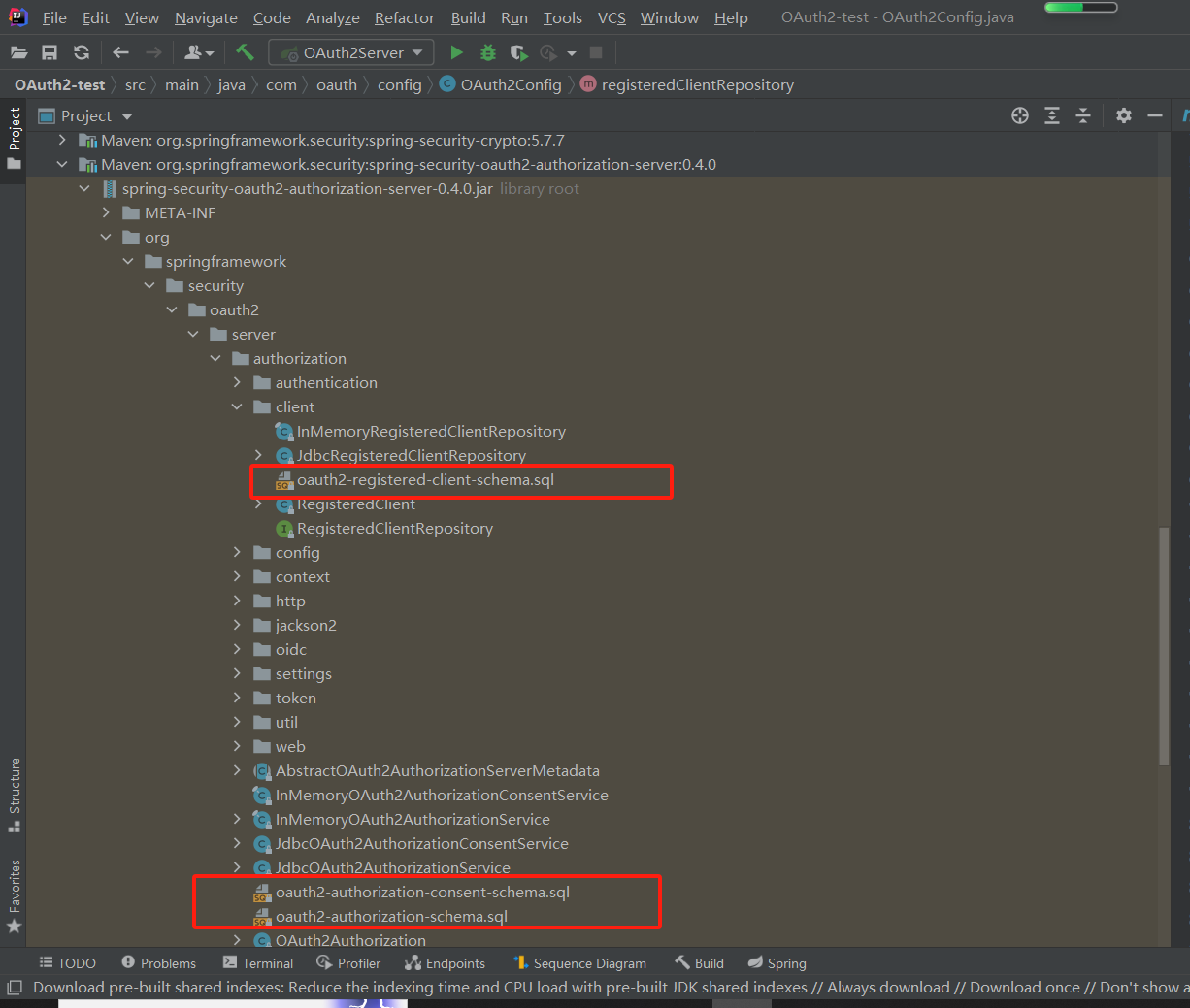
资源服务搭建
总体预览
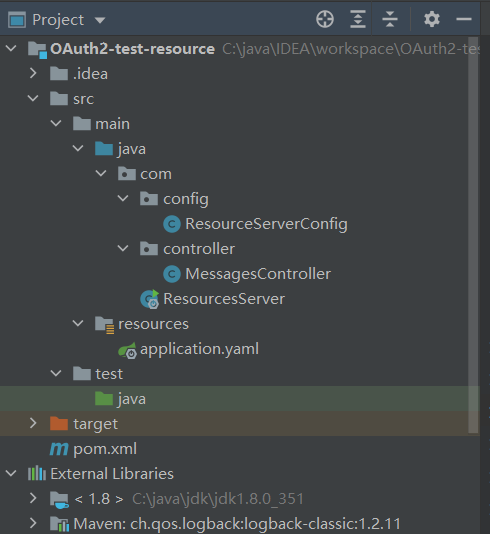
pom
<?xml version="1.0" encoding="UTF-8"?>
<project xmlns="http://maven.apache.org/POM/4.0.0"
xmlns:xsi="http://www.w3.org/2001/XMLSchema-instance"
xsi:schemaLocation="http://maven.apache.org/POM/4.0.0 http://maven.apache.org/xsd/maven-4.0.0.xsd">
<modelVersion>4.0.0</modelVersion>
<groupId>org.example</groupId>
<artifactId>OAuth2-test-resource</artifactId>
<version>1.0-SNAPSHOT</version>
<properties>
<maven.compiler.source>8</maven.compiler.source>
<maven.compiler.target>8</maven.compiler.target>
</properties>
<parent>
<groupId>org.springframework.boot</groupId>
<artifactId>spring-boot-starter-parent</artifactId>
<version>2.7.10</version>
</parent>
<dependencies>
<dependency>
<groupId>org.springframework.boot</groupId>
<artifactId>spring-boot-starter-security</artifactId>
</dependency>
<dependency>
<groupId>org.springframework.boot</groupId>
<artifactId>spring-boot-starter-oauth2-resource-server</artifactId>
</dependency>
<dependency>
<groupId>org.springframework.boot</groupId>
<artifactId>spring-boot-starter-web</artifactId>
</dependency>
<dependency>
<groupId>org.projectlombok</groupId>
<artifactId>lombok</artifactId>
</dependency>
</dependencies>
<build>
<plugins>
<plugin>
<groupId>org.springframework.boot</groupId>
<artifactId>spring-boot-maven-plugin</artifactId>
</plugin>
</plugins>
</build>
</project>
配置类
import org.springframework.context.annotation.Bean;
import org.springframework.context.annotation.Configuration;
import org.springframework.security.config.annotation.web.builders.HttpSecurity;
import org.springframework.security.config.annotation.web.configuration.EnableWebSecurity;
import org.springframework.security.web.SecurityFilterChain;
@EnableWebSecurity
@Configuration
public class ResourceServerConfig {
@Bean
SecurityFilterChain securityFilterChain(HttpSecurity http) throws Exception {
http
//所有请求都需要验证
.authorizeHttpRequests(authorize -> authorize.anyRequest().authenticated())
//开启jwt,用于令牌解析
.oauth2ResourceServer(resourceServer -> resourceServer.jwt());
return http.build();
}
}
yaml
server:
port: 8081
spring:
security:
oauth2:
resourceserver:
jwt:
#项目启动初始化时,在JwtDecoderProviderConfigurationUtils的getConfiguration方法处,发起http://127.0.0.1:8080/.well-known/openid-configuration请求,向授权服务获取元数据端点信息,
#此项为必须配置,资源服务会根据此地址获取的信息来对token进行验证
issuer-uri: http://127.0.0.1:8080
#如果配置了issuer-uri,此项可以不配置。因为通过issuer-uri配置的值,在JwtDecoders的withProviderConfiguration方法中自动获取为http://127.0.0.1:8080/oauth2/jwks
#jwk-set-uri: http://127.0.0.1:8080/oauth2/jwks
controller
import org.springframework.security.access.prepost.PreAuthorize;
import org.springframework.web.bind.annotation.GetMapping;
import org.springframework.web.bind.annotation.RestController;
@RestController
public class MessagesController {
@GetMapping("/read/resource")
@PreAuthorize("hasAuthority('SCOPE_read')")//限制访问资源所需要的权限
public String getResource1(){
return "已成功获取资源";
}
}
主启动类
import org.springframework.boot.SpringApplication;
import org.springframework.boot.autoconfigure.SpringBootApplication;
@SpringBootApplication
public class ResourcesServer {
public static void main(String[] args) {
SpringApplication.run(ResourcesServer.class, args);
}
}
请求测试
第一步注册用户与客户端
注册用户
三个参数分别是用户名、密码、权限
http://127.0.0.1:8080/register/user?userName=wzy&password=wzy&role=ADMIN
执行:

查看用户表

注册客户端
http://127.0.0.1:8080/register/client
请求体json
- id:客户端id
- secret:客户端密钥
- redirectUri:重定向地址,授权服务会将授权码通过此地址返回给客户端
- scopes:客户端的权限范围
{
"id": "test-client",
"secret": "FjKNY8p2&Xw9Lqe$GH7Rd3Bt*5mZ4Pv#CV2sE6J!n",
"redirectUri": "http://127.0.0.1:8080/register/returnCode",
"scopes": ["read", "write"]
}
执行请求
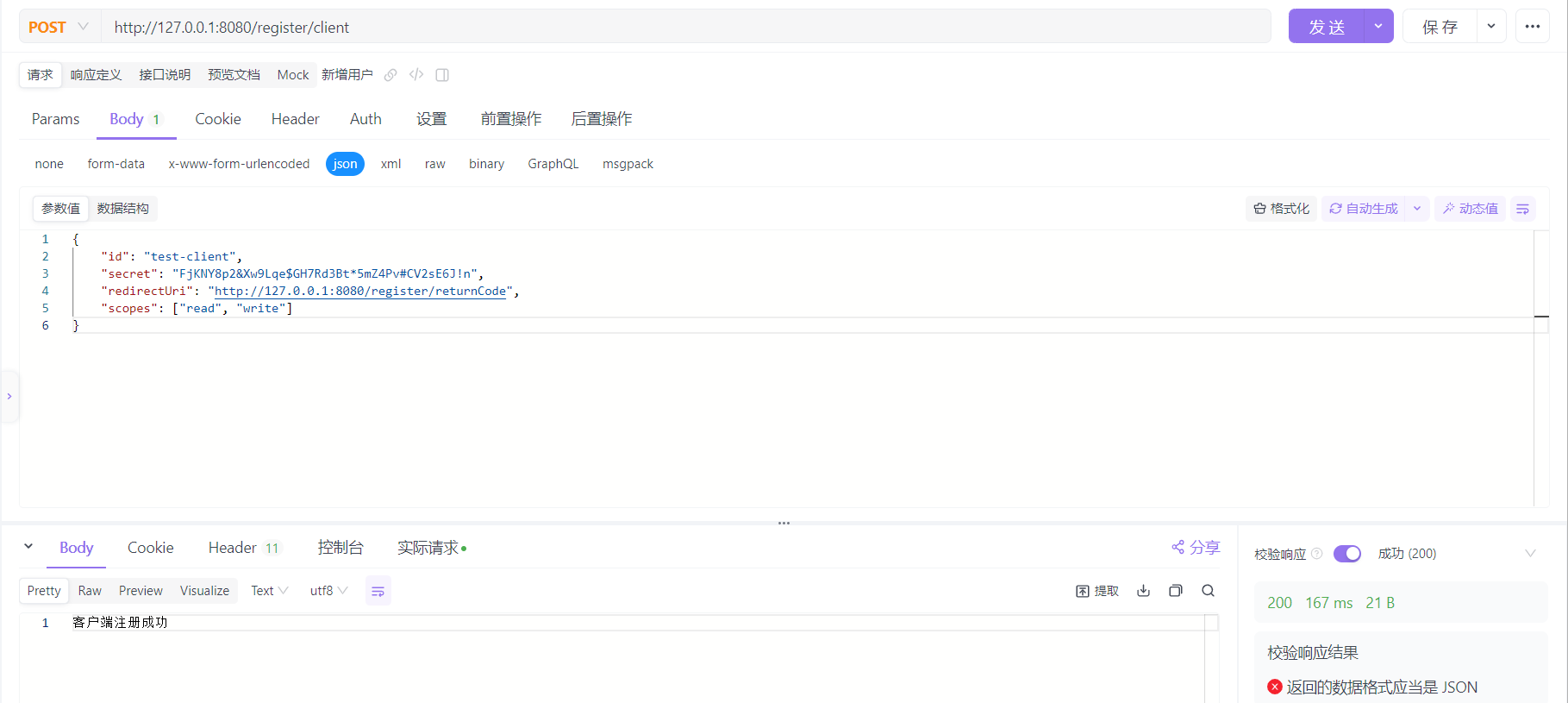
查看数据库表oauth2_registered_client中是否注册上:
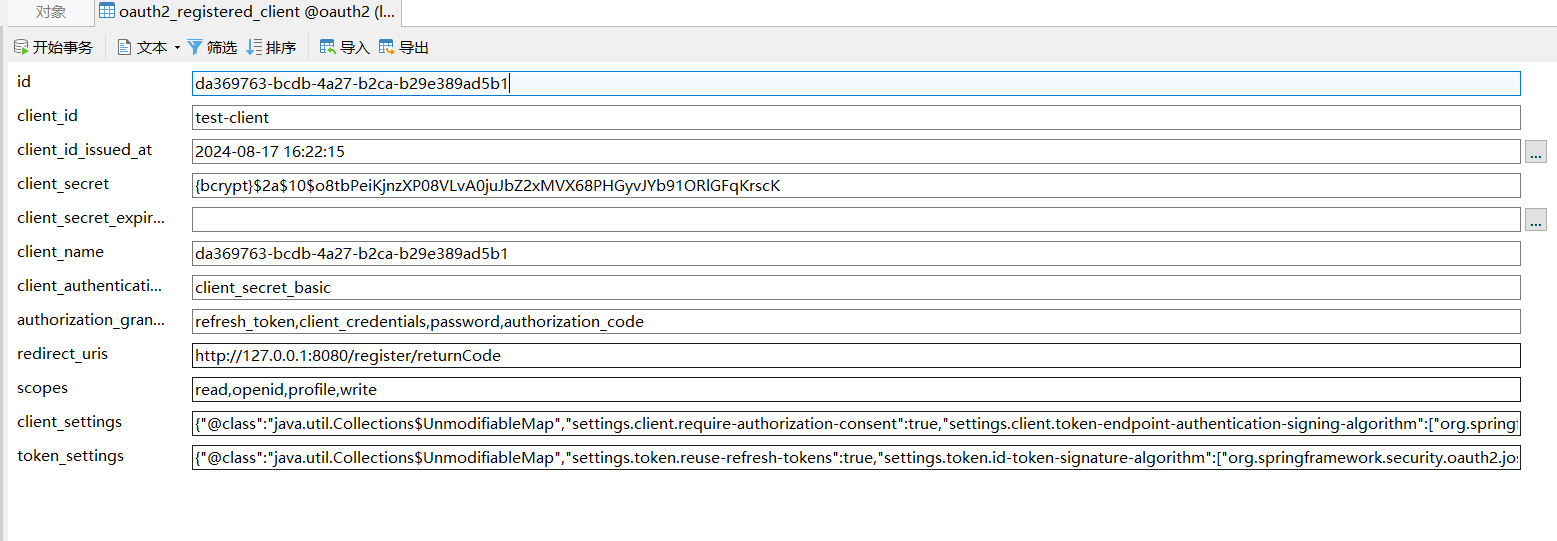
第二步获取授权码
oauth2/authorize路径为security默认的授权码请求路径
http://127.0.0.1:8080/oauth2/authorize?response_type=code&client_id=test-client&scope=read&redirect_uri=http://127.0.0.1:8080/register/returnCode
其他参数解释:
- response_type:表示客户端请求授权码
- client_id:客户端id
- scope:客户端权限范围
- redirect_uri:客户端重定向地址,要与与注册时一致
这些参数会由授权服务获取,来进行授权认证。
浏览器输入上面地址回车,自动跳转如下页面,输入注册的用户名密码点击Sign in:

上面登录后,会再跳转到下面的授权页面,勾选要授予的权限read,然后Submit:
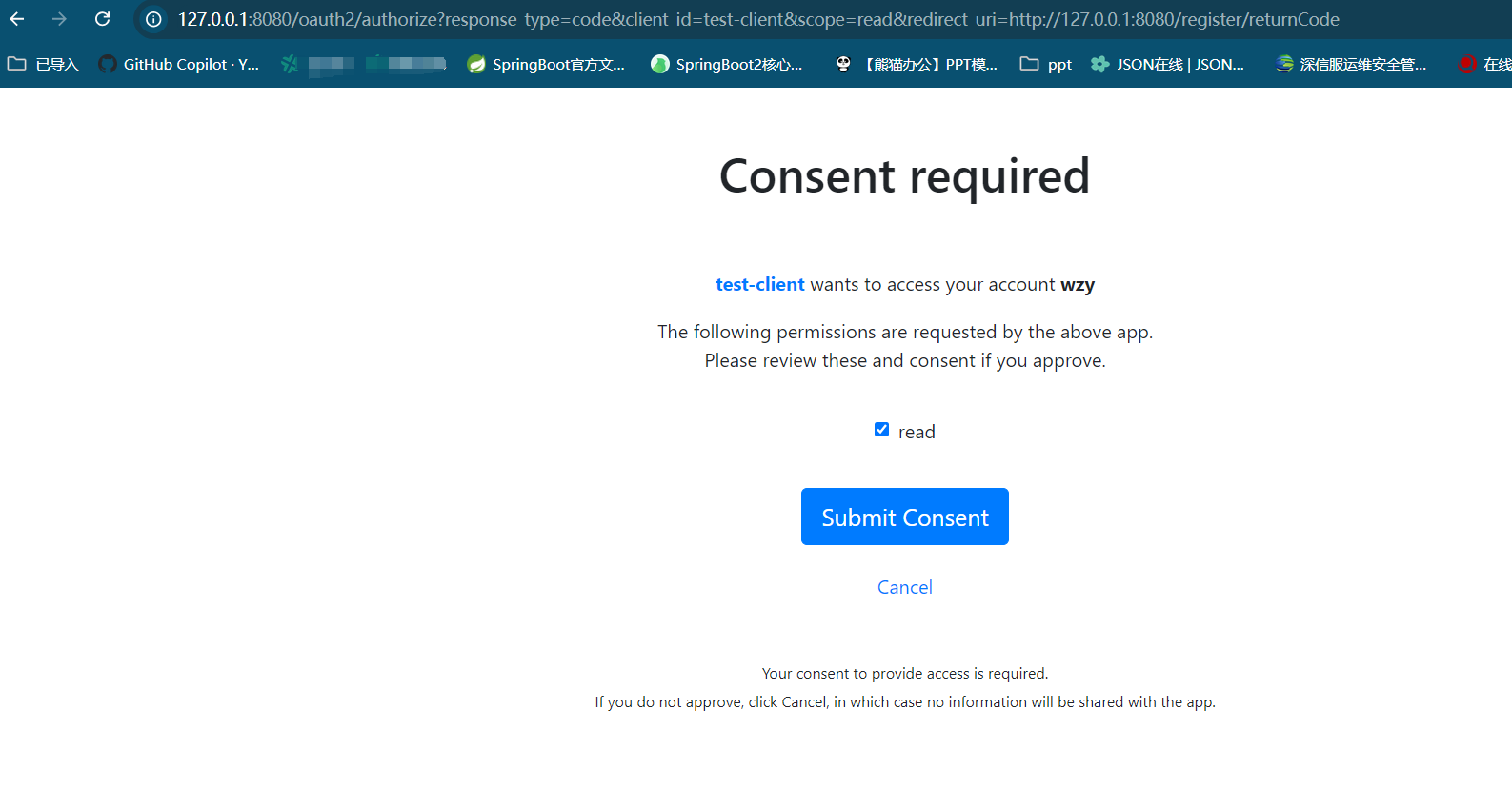
然后会获得授权码:

第三步换取token
请求地址
http://127.0.0.1:8080/oauth2/token
需要的参数
grant_type:授权模式,此处使用授权码模式,值固定为authorization_codecode:上一步返回的授权码redirect_uri:重定向地址,与注册客户端时保持一致- client_id:客户端id,表单中可去除参数,不是必须
- client_secret:客户端密钥,表单中可去除参数,不是必须
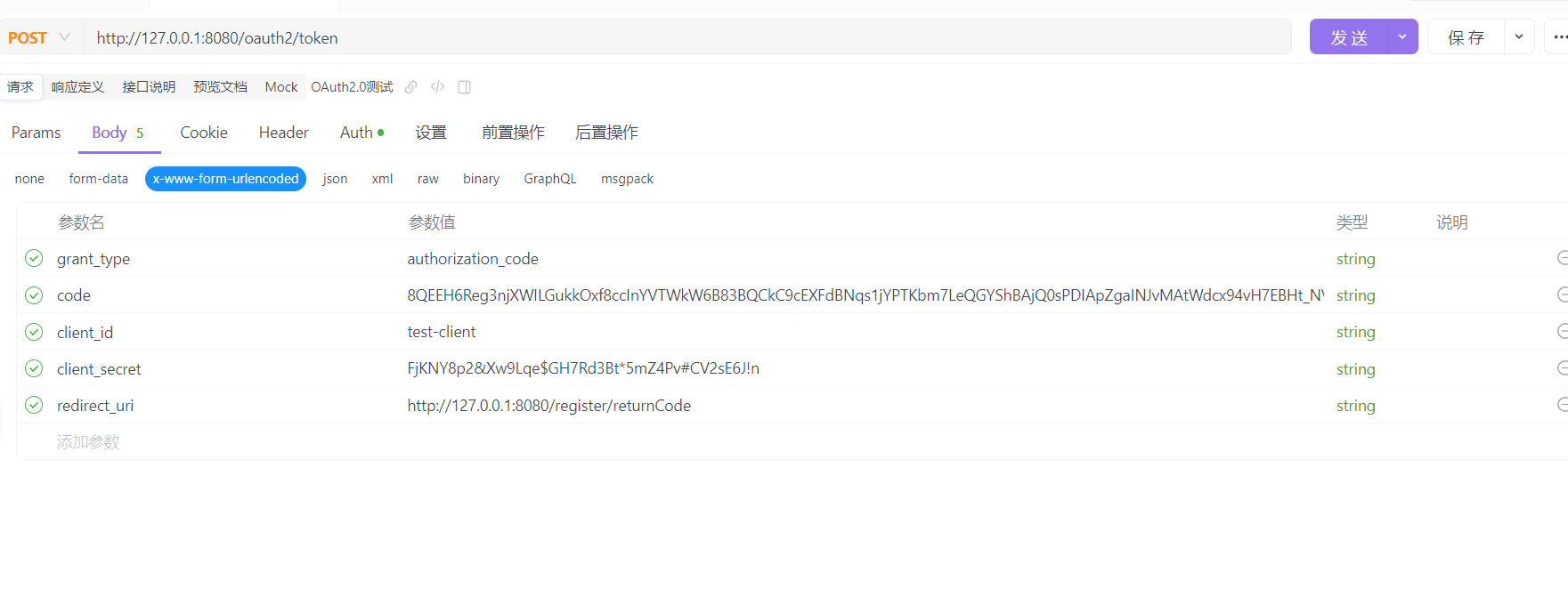
请求头Auth处为必填,因为授权服务要验证客户端身份,类型选Bacis Auth,Username为客户端id,Password为客户端密钥(未加密的)

如果你用的是postman,要按如下方式填写:

实际请求中,Auth对应请求头的'Authorization: Basic dGVzdC1jbGllbnQ6RmpLTlk4cDImWHc5THFlJEdIN1JkM0J0KjVtWjRQdiNDVjJzRTZKIW4=',Basic后面是客户端id与密钥经过编码后的值,下面是实际请求展示:
curl --location --request POST 'http://127.0.0.1:8080/oauth2/token' \
--header 'User-Agent: Apifox/1.0.0 (https://apifox.com)' \
--header 'Authorization: Basic dGVzdC1jbGllbnQ6RmpLTlk4cDImWHc5THFlJEdIN1JkM0J0KjVtWjRQdiNDVjJzRTZKIW4=' \
--header 'Accept: */*' \
--header 'Host: 127.0.0.1:8080' \
--header 'Connection: keep-alive' \
--header 'Content-Type: application/x-www-form-urlencoded' \
--data-urlencode 'grant_type=authorization_code' \
--data-urlencode 'code=ORM8bkef2X1fhvCmrIqzXSwzYwxD-RbD4yzcotRVW36iaLJJMiLLoCe7kbRCWtmMVGCB7ESJAqkBUbSC_zoUL5KXEX63f4Mc1MVTLe_DS-PKpvAwqzYb7Hv1qQ1ftLeZ' \
--data-urlencode 'redirect_uri=http://127.0.0.1:8080/register/returnCode'
点击发送后,返回的
access_token即为令牌token
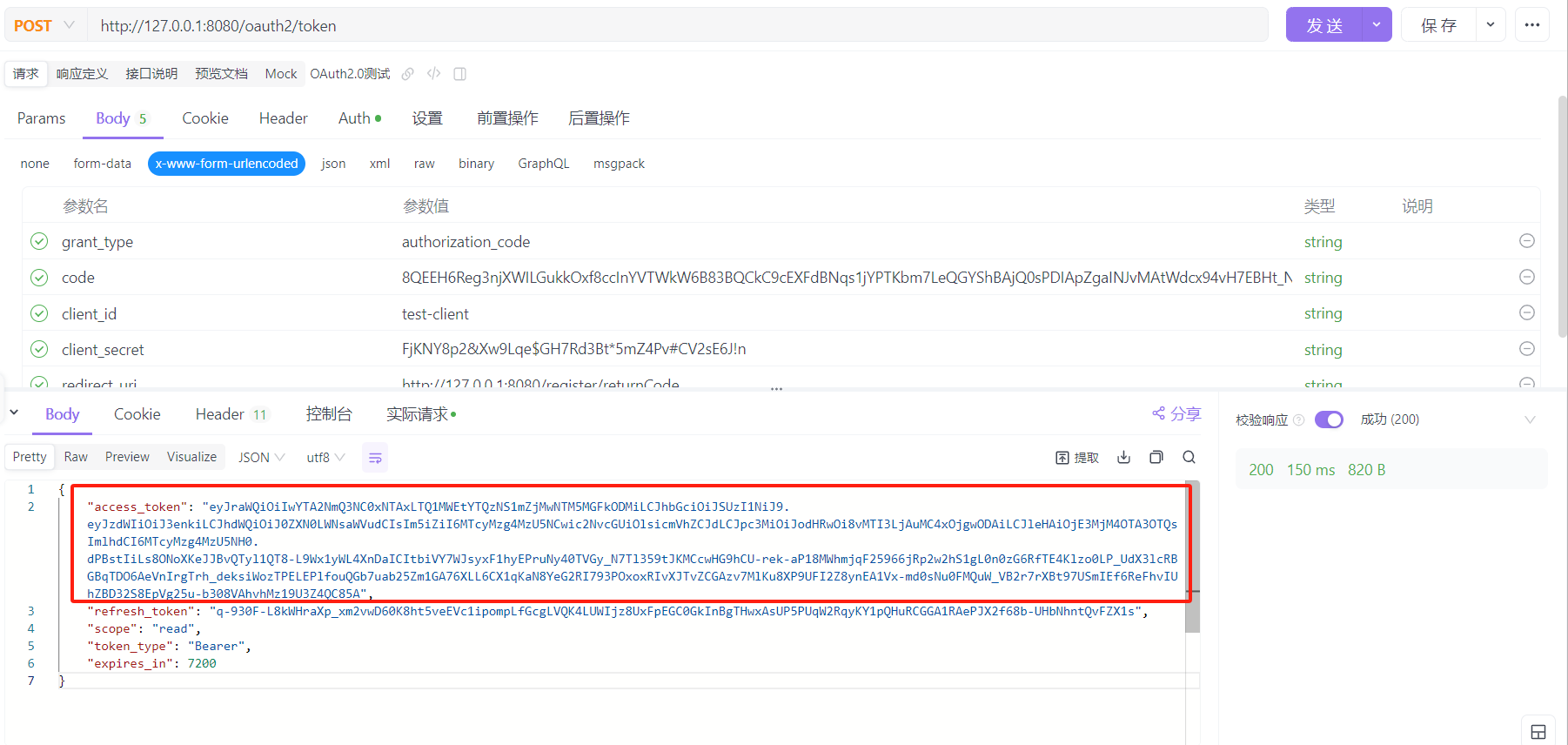
需要注意的是:授权码是一次性的,换取token后,原授权码就会失效,再获取token要使用新的授权码
最后获取资源
地址为资源服务的controller地址
http://127.0.0.1:8081/read/resource
参数如下,token处填的就是上面获取的access_token,发送后返回已成功获取资源,即为成功
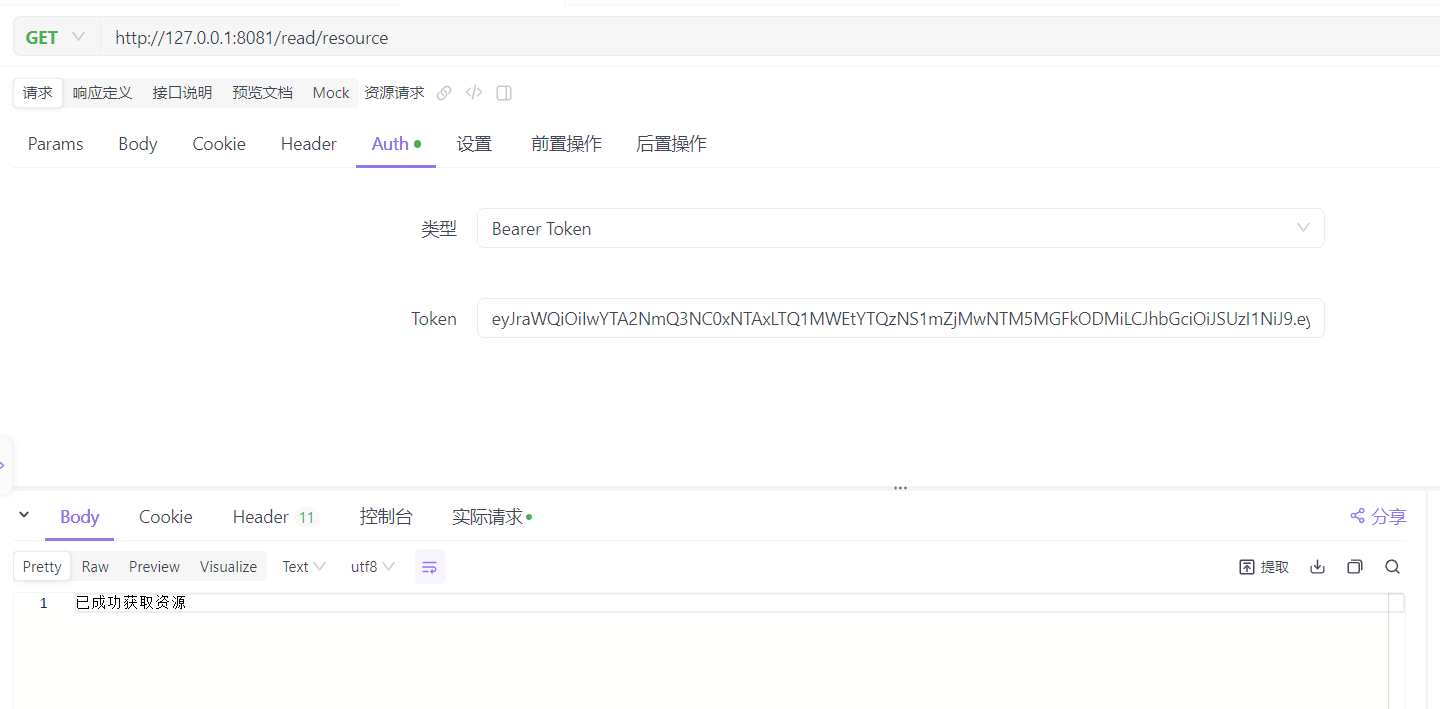
如果是postman测试工具,按照如下填写:
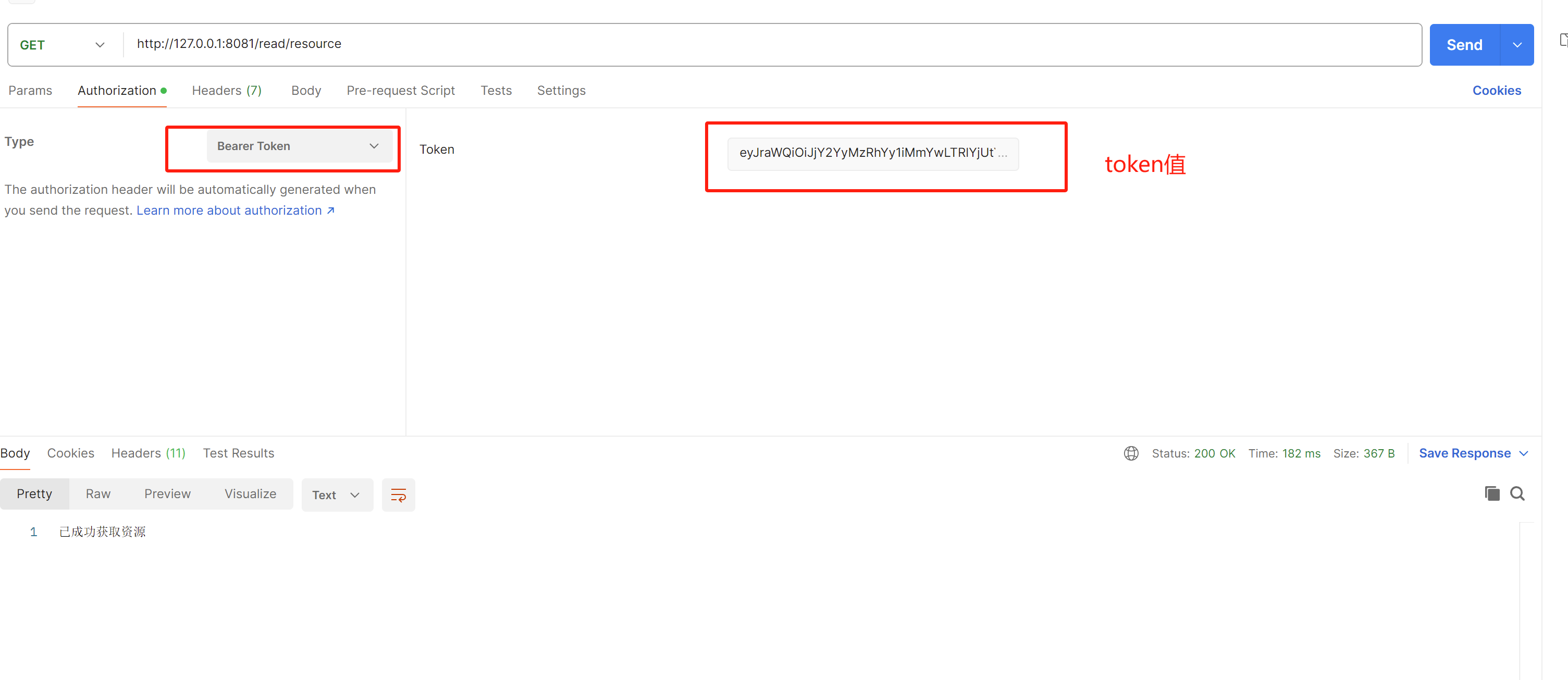
客户端
关于客户端,其实在上面的请求测试中,我们已经模拟了客户端的操作。
在实际开发中,也存在许多客户端的变体形式,可能是前后端分离的前端项目,也有可能是单独的后端微服务程序,这里以单独的Spring Boot后端程序展示OAuth2 Clinet的使用。
Spring Boot同样提供了OAuth2的客户端集成,在授权码模式下,使用spring-boot-starter-oauth2-client结合@RegisteredOAuth2AuthorizedClient注解,客户端可以自动实现授权码的请求及令牌的获取,而不需要上面的手动请求操作。
总体预览
因为SpringBoot-OAuth2的请求缓存默认使用session实现,本文演示又使用了三个不同端口的服务,所以结合spring-session-data-redis实现会话管理,来达到自动请求的目的。
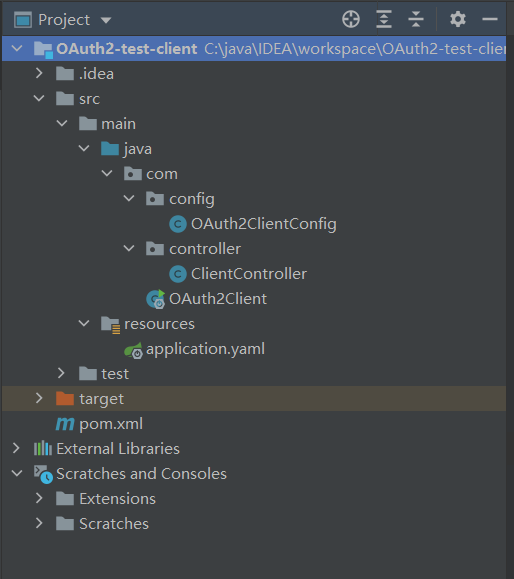
pom
<?xml version="1.0" encoding="UTF-8"?>
<project xmlns="http://maven.apache.org/POM/4.0.0"
xmlns:xsi="http://www.w3.org/2001/XMLSchema-instance"
xsi:schemaLocation="http://maven.apache.org/POM/4.0.0 http://maven.apache.org/xsd/maven-4.0.0.xsd">
<modelVersion>4.0.0</modelVersion>
<groupId>org.example</groupId>
<artifactId>OAuth2-test-client</artifactId>
<version>1.0-SNAPSHOT</version>
<properties>
<maven.compiler.source>8</maven.compiler.source>
<maven.compiler.target>8</maven.compiler.target>
</properties>
<parent>
<groupId>org.springframework.boot</groupId>
<artifactId>spring-boot-starter-parent</artifactId>
<version>2.7.10</version>
</parent>
<dependencies>
<dependency>
<groupId>org.springframework.boot</groupId>
<artifactId>spring-boot-starter-web</artifactId>
</dependency>
<dependency>
<groupId>org.springframework.boot</groupId>
<artifactId>spring-boot-starter-security</artifactId>
</dependency>
<dependency>
<groupId>org.springframework.boot</groupId>
<artifactId>spring-boot-starter-oauth2-client</artifactId>
</dependency>
<!-- 用于客户端向资源服务发起请求 -->
<dependency>
<groupId>org.springframework.boot</groupId>
<artifactId>spring-boot-starter-webflux</artifactId>
</dependency>
<!-- 使用redis管理会话,实现不同服务的session共享 -->
<dependency>
<groupId>org.springframework.boot</groupId>
<artifactId>spring-boot-starter-data-redis</artifactId>
</dependency>
<dependency>
<groupId>org.springframework.session</groupId>
<artifactId>spring-session-data-redis</artifactId>
</dependency>
</dependencies>
</project>
yaml
server:
port: 8082
spring:
security:
oauth2:
client:
registration:
#除了重定向地址,此处的客户端各项配置要与授权服务注册客户端的RegisterController中一致
test-client:
provider: oauth2server #这里的值可以自定义,需要和下面的issuer-uri上面的一致
client-id: test-client #客户端id
client-secret: FjKNY8p2&Xw9Lqe$GH7Rd3Bt*5mZ4Pv#CV2sE6J!n #客户端密钥
client-authentication-method: client_secret_basic #客户端认证方式
authorization-grant-type: authorization_code #客户端支持的授权模式
#重定向地址,格式在下方注释,这里要修改为:'客户端ip:port/login/oauth2/code/客户端id值'
redirect-uri: "http://127.0.0.1:8082/login/oauth2/code/test-client"
#redirect-uri: "{baseUrl}/{action}/oauth2/code/{registrationId}"
scope: read,openid,profile,write #权限
provider:
# 配置服务提供地址
oauth2server:
# issuer-uri 用于客户端向授权服务获取jwks信息
issuer-uri: http://127.0.0.1:8080
#共享session使用redis配置
redis:
host: 127.0.0.1
port: 6379
config
package com.config;
import org.springframework.context.annotation.Bean;
import org.springframework.context.annotation.Configuration;
import org.springframework.security.config.Customizer;
import org.springframework.security.config.annotation.web.builders.HttpSecurity;
import org.springframework.security.config.annotation.web.configuration.EnableWebSecurity;
import org.springframework.security.config.http.SessionCreationPolicy;
import org.springframework.security.web.SecurityFilterChain;
@EnableWebSecurity
@Configuration
public class OAuth2ClientConfig {
@Bean
SecurityFilterChain securityFilterChain(HttpSecurity http) throws Exception {
http
.authorizeHttpRequests(authorize -> authorize
.anyRequest().authenticated()//所有请求都需要认证
)
//security默认情况下使用的oauth2Login配置
.oauth2Login(Customizer.withDefaults())
//security默认情况下使用的oauth2Client配置
.oauth2Client(Customizer.withDefaults())
//总是开启session
.sessionManagement().sessionCreationPolicy(SessionCreationPolicy.ALWAYS);
return http.build();
}
}
controller
使用
@RegisteredOAuth2AuthorizedClient注解作用:
- 当客户端请求资源并经过授权服务的认证后,客户端默认会将认证通过信息保存在内存中;
@RegisteredOAuth2AuthorizedClient会使用Spring MVC的请求参数解析器,将保存的认证信息转为Controller的方法参数OAuth2AuthorizedClient对象;- 最后在Controller中,可以直接从转换的
OAuth2AuthorizedClient中取出token,再请求资源示例如下:
package com.controller;
import org.springframework.security.oauth2.client.OAuth2AuthorizedClient;
import org.springframework.security.oauth2.client.annotation.RegisteredOAuth2AuthorizedClient;
import org.springframework.web.bind.annotation.GetMapping;
import org.springframework.web.bind.annotation.RequestMapping;
import org.springframework.web.bind.annotation.RestController;
import org.springframework.web.reactive.function.client.WebClient;
import reactor.core.publisher.Mono;
@RestController
@RequestMapping("/getResource")
public class ClientController {
@GetMapping("/getToken")
public String getToken(@RegisteredOAuth2AuthorizedClient("test-client") OAuth2AuthorizedClient oAuth2AuthorizedClient) {
return oAuth2AuthorizedClient.getAccessToken().getTokenValue();
}
@GetMapping("/read")
public String getServerARes1(@RegisteredOAuth2AuthorizedClient("test-client") OAuth2AuthorizedClient oAuth2AuthorizedClient) {
//向资源服务发起请求,获取资源
return getServer("http://127.0.0.1:8081/read/resource", oAuth2AuthorizedClient);
}
@GetMapping("/write")
public String getServerARes2(@RegisteredOAuth2AuthorizedClient("test-client") OAuth2AuthorizedClient oAuth2AuthorizedClient) {
//向资源服务发起请求,获取资源
return getServer("http://127.0.0.1:8081/write/resource", oAuth2AuthorizedClient);
}
/**
* 获取token,请求资源服务
*/
private String getServer(String url, OAuth2AuthorizedClient oAuth2AuthorizedClient) {
// 获取 access_token
String tokenValue = oAuth2AuthorizedClient.getAccessToken().getTokenValue();
// 发起请求
Mono<String> stringMono = WebClient.builder()
.defaultHeader("Authorization", "Bearer " + tokenValue)
.build()
.get()
.uri(url)
.retrieve()
.bodyToMono(String.class);
return stringMono.block();
}
}
上面多了个write请求,将资源服务项目示例的Controller改为如下即可
package com.controller;
import org.springframework.security.access.prepost.PreAuthorize;
import org.springframework.web.bind.annotation.GetMapping;
import org.springframework.web.bind.annotation.RestController;
@RestController
public class MessagesController {
@GetMapping("/read/resource")
@PreAuthorize("hasAuthority('SCOPE_read')")//限制访问资源所需要的权限
public String getResource1(){
return "已成功获取资源";
}
@GetMapping("/write/resource")
@PreAuthorize("hasAuthority('SCOPE_write')")//限制访问资源所需要的权限
public String getResource2(){
return "已成功获取资源2";
}
}
主启动类
import org.springframework.boot.SpringApplication;
import org.springframework.boot.autoconfigure.SpringBootApplication;
@SpringBootApplication
public class OAuth2Client {
public static void main(String[] args) {
SpringApplication.run(OAuth2Client.class, args);
}
}
数据表修改
需要将
oauth2_registered_client表中,注册客户端的重定向地址改为yaml中配置的地址,即:http://127.0.0.1:8082/login/oauth2/code/test-client。如果不使用此地址,授权服务无法将授权码自动返回给客户端
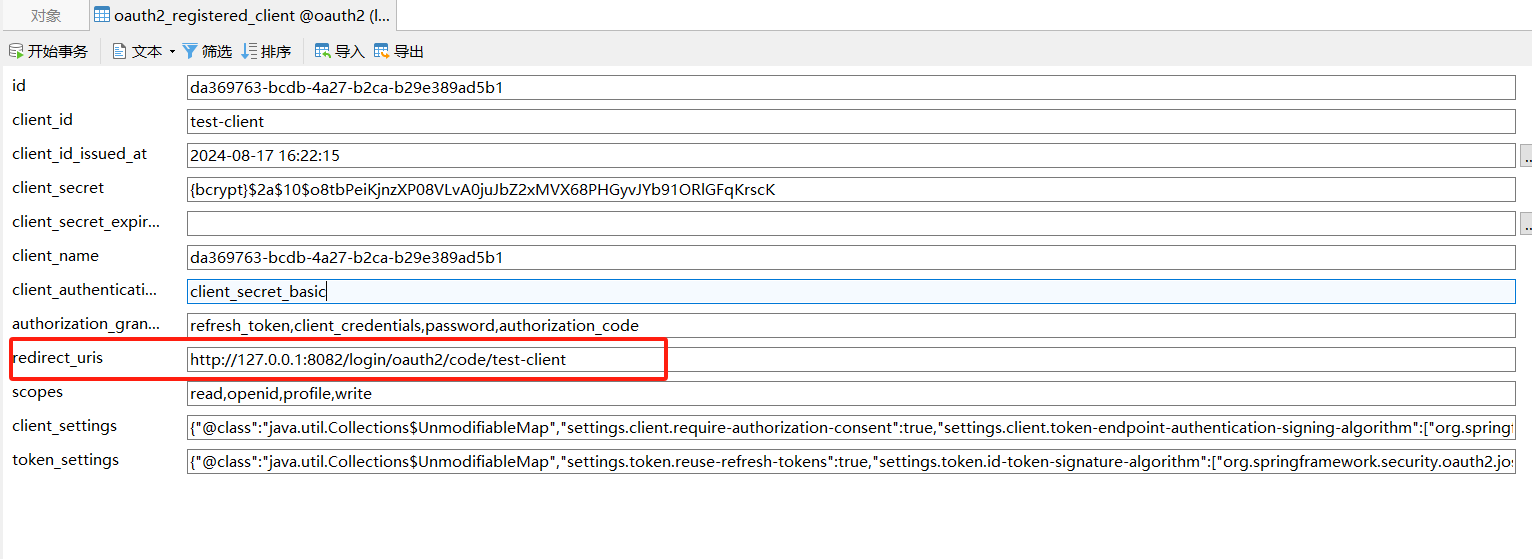
为了展示新的效果,清空oauth2_authorization、oauth2_authorization_consent两张表的数据
客户端测试
先启动redis,然后是授权服务,最后启动资源服务与客户端。
浏览器发起如下请求,来请求资源:
http://127.0.0.1:8082/getResource/read
127.0.0.1:8082/getResource/read是客户端向资源服务请求资源的地址,发起请求后,因为没有权限,会被客户端过滤器拦截(第一次请求还没有保存认证信息在上下文中)。
拦截后,客户端会向授权服务发起授权码请求,然后授权服务会要求用户登录授权,所以返回的是127.0.0.1:8080/login的登录页面:
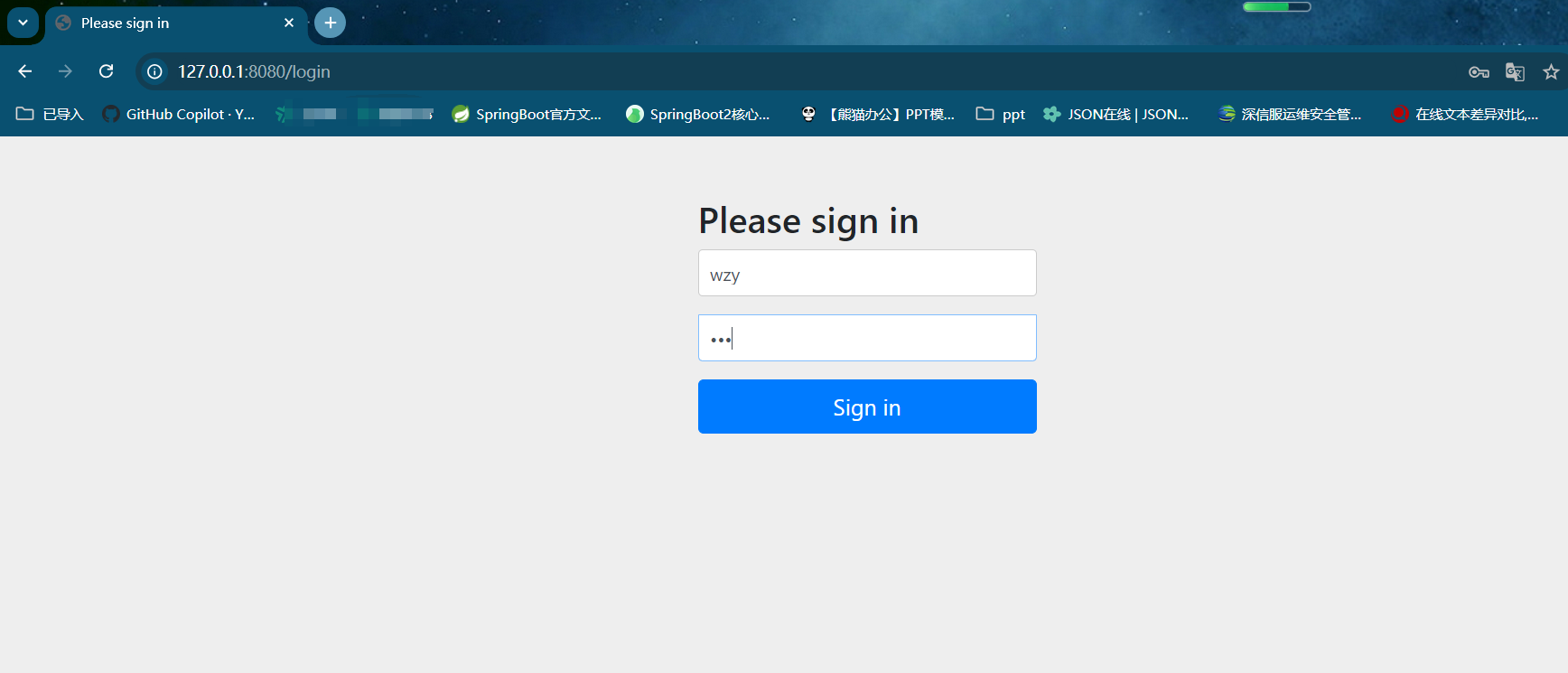
进行登录后,来到授权页面:

下面是图中授权页面的地址栏信息,包含客户端id、权限范围、state、重定向地址等参数:
http://127.0.0.1:8080/oauth2/authorize?response_type=code&client_id=test-client&scope=read%20openid%20profile%20write&state=M43A6Pvs7ce-a98FigCQSsvPWkp4Rhs3bgr9xQLdKsE%3D&redirect_uri=http://127.0.0.1:8082/login/oauth2/code/test-client&nonce=Y3U-NfewZBtI6P24GtRRwHuzvUx-3ZfVGh6a_jh9Rys
然后勾选三个权限,并点击submit提交。
提交后,会直接跳转到资源。授权码的获取、交换令牌、携带令牌访问资源的过程,已经由框架为我们自动实现
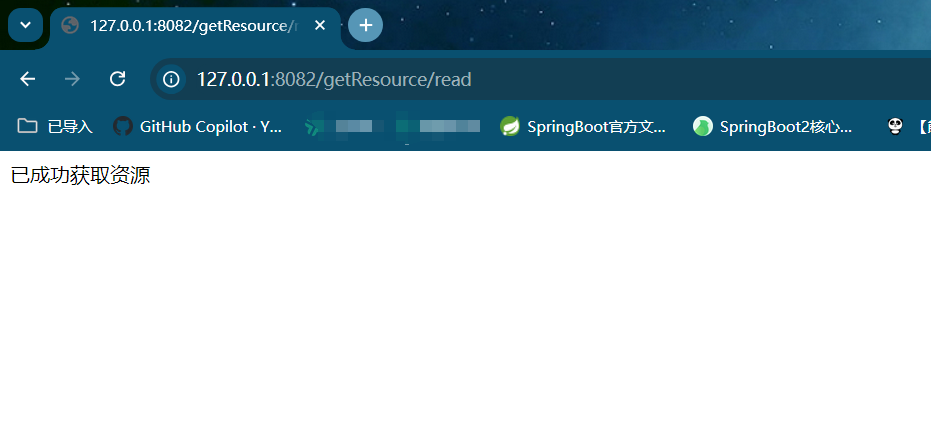
在发起另一个资源的访问请求:
http://127.0.0.1:8082/getResource/write
因为已经登录授权过,所以第二个资源会直接返回:
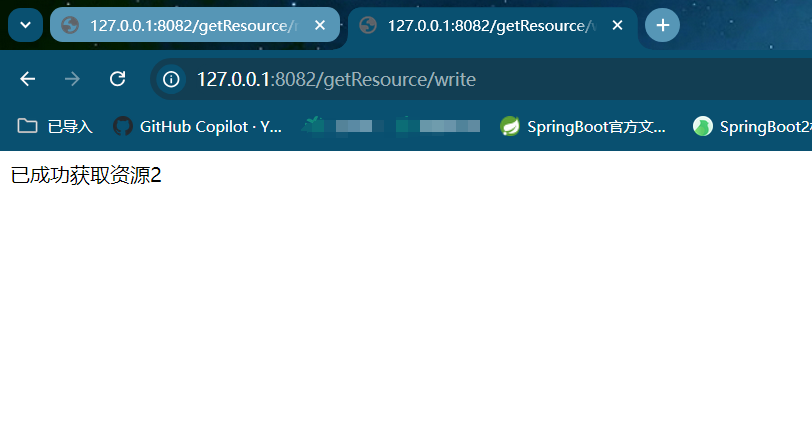
通过请求测试可以发现,进行登录授权后,浏览器直接访问到了资源,而无需再手动进行授权码及token部分的操作,实现了客户端自动获取资源的效果。
